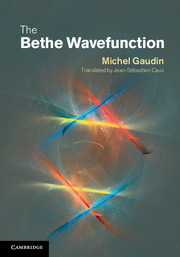Book contents
- Frontmatter
- Contents
- Foreword
- Translator's note
- Introduction
- 1 The chain of spin-1/2 atoms
- 2 Thermodynamic limit of the Heisenberg–Ising chain
- 3 Thermodynamics of the spin-1/2 chain: Limiting cases
- 4 δ-Interacting bosons
- 5 Bethe wavefunctions associated with a reflection group
- 6 Continuum limit of the spin chain
- 7 The six-vertex model
- 8 The eight-vertex model
- 9 The eight-vertex model: Eigenvectors and thermodynamics
- 10 Identical particles with δ-interactions
- 11 Identical particles with δ-interactions: General solution for two internal states
- 12 Identical particles with δ-interactions: General solution for n components and limiting cases
- 13 Various corollaries and extensions
- 14 On the Toda chain
- References
- Index
7 - The six-vertex model
Published online by Cambridge University Press: 05 April 2014
- Frontmatter
- Contents
- Foreword
- Translator's note
- Introduction
- 1 The chain of spin-1/2 atoms
- 2 Thermodynamic limit of the Heisenberg–Ising chain
- 3 Thermodynamics of the spin-1/2 chain: Limiting cases
- 4 δ-Interacting bosons
- 5 Bethe wavefunctions associated with a reflection group
- 6 Continuum limit of the spin chain
- 7 The six-vertex model
- 8 The eight-vertex model
- 9 The eight-vertex model: Eigenvectors and thermodynamics
- 10 Identical particles with δ-interactions
- 11 Identical particles with δ-interactions: General solution for two internal states
- 12 Identical particles with δ-interactions: General solution for n components and limiting cases
- 13 Various corollaries and extensions
- 14 On the Toda chain
- References
- Index
Summary
The ice model
Introduction
The six-vertex model, which is the object of this chapter, is a special case of the eight-vertex model on a two-dimensional square lattice introduced by Fan and Wu (1970) in order to summarize a class of exactly solvable models in classical statistical mechanics. The thermodynamics of the six-vertex model is by now known in its full generality (Yang and Yang, 1966a–d; Lieb, 1967a) which is not the case for the eight-vertex model, but only the self-conjugate one (Baxter, 1971a).
The general model can be considered as a two-dimensional idealization of a crystalline system in which pairs of adjacent atoms or radicals on the network are linked by ‘hydrogen bonds’. Of ionic type, this link between two neighbouring electronegative atoms is realized by a proton H+ which is located closer to one of the atoms than to the other. On each link of the network there thus exist two equilibrium positions for H+ (Pauling, 1960). If the coordination number at each site equals 4, as is the case for the oxygen atom in hexagonal ice, we indeed have eight possible proton configurations on a given site, which give rise to the eight vertices.
In contrast, for the physical systems for which this model could be viewed as a valid idealization – ice H2O, the ferroelectric PO4H2K, the antiferroelectric PO4H2NH4 – there exist at most two H+ next to each site.
- Type
- Chapter
- Information
- The Bethe Wavefunction , pp. 112 - 141Publisher: Cambridge University PressPrint publication year: 2014

